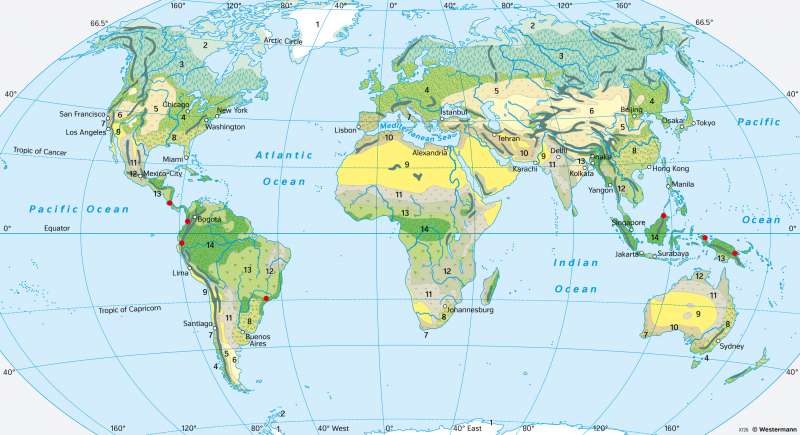The World - Ecozones (according to J. Schultz)
Ecozones and natural hazards
978-3-14-100890-6 | Page 22 | Ill. 1

Overview
The map illustrates the Earth's ecozones according to the subdivision introduced by Jürgen Schultz in 1988. Ecozones are large areas on the Earth's mainland with independent climatic agenesis, morphodynamics, similar soil formation processes, comparable lifestyles of plants and animals, and analogous yields in agriculture and forestry. Accordingly, they differ according to the annual and daily climatic variation, the exogenous landforms, the soil types, the plant formations and biomes as well as the agricultural and forestry use. According to Schultz's classification, the Earth is made up of nine ecozones, some of which are subdivided into eco-subzones.
The ecozonal division of the Earth
In the hierarchical system of habitats, whose basic unit is the ecotope, the term ecozone designates the highest level of order. It is therefore the first subdivision of the ecosphere (the totality of the biosphere and the sub-areas of the lithosphere, pedosphere, hydrosphere and atmosphere connected to it through interactions such as energy flows and material cycles).
The ecozonal division of the Earth according to J. Schultz comprises nine ecozones and several eco-subzones. The classification is primarily based on natural criteria. Aspects of cultural space are only taken into account if references to natural features are recognisable. Such references are present, for example, in land use..
Boundaries and zonification
The boundaries between the ecozones shown on the map roughly follow the climatic zonal division of the Earth by Troll and Paffen. This, in turn, is based on an effective climate classification, in which priority is given to the effects of climate elements on the natural and cultural environment. In the past, this climate classification did good justice to the Earth-spatial and zonal differentiation of vegetation - in the meantime, however, the first spatial deviations and inconsistencies in detail are already emerging due to global climate change.
Some ecozones are divided into zonally oriented sub-regions, such as the Polar/Subpolar Zone into the ice-covered polar regions (ice desert) as well as tundras and frost heaps. The Tropical/Subtropical Dry Zones are divided into deserts and semi-deserts, winter-wet grass and shrub steppes, and summer-wet thorn steppes.
Such an ecozonal classification of the entire Earth naturally involves a certain simplification. The current vegetation zones along with the extent of the world's cultivated land are shown on the large world map on the following pages.




